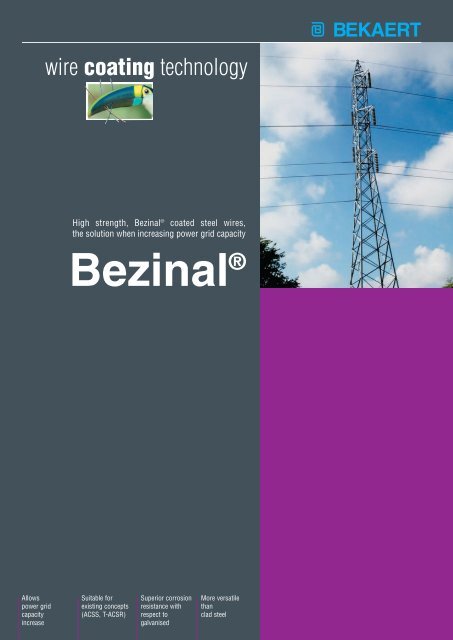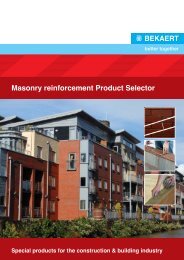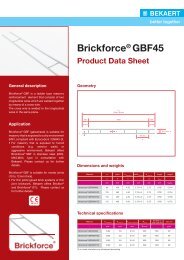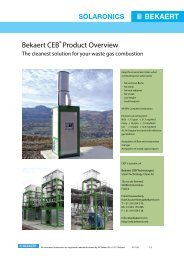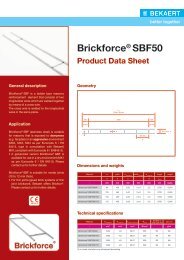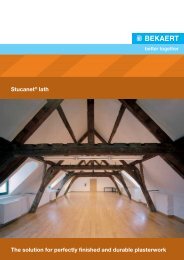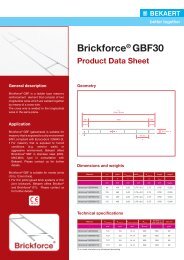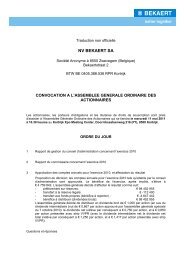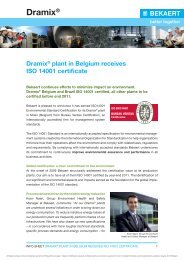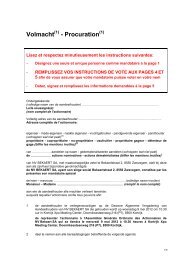Bezinal Voltage 32luik - Bekaert
Bezinal Voltage 32luik - Bekaert
Bezinal Voltage 32luik - Bekaert
Create successful ePaper yourself
Turn your PDF publications into a flip-book with our unique Google optimized e-Paper software.
wire coating technology<br />
BEKAERT<br />
High strength, <strong>Bezinal</strong> ® coated steel wires,<br />
the solution when increasing power grid capacity<br />
<strong>Bezinal</strong> ®<br />
Allows<br />
power grid<br />
capacity<br />
increase<br />
Suitable for<br />
existing concepts<br />
(ACSS, T-ACSR)<br />
Superior corrosion<br />
resistance with<br />
respect to<br />
galvanised<br />
More versatile<br />
than<br />
clad steel
Increasing the capacity of high voltage power lines goes together<br />
with a substantial increase in operating temperature. Safe and<br />
reliable operation conditions require high strength steel wires<br />
coated with<br />
<strong>Bezinal</strong> ®<br />
Zn + Al<br />
95% 5%<br />
Fe<br />
Advantages:<br />
▲<br />
Allow substantial power grid capacity increase<br />
• Safe operation at low and high temeratures<br />
• Mechanically stable in a broad temperature domain<br />
• No flaking of the coating at elevated temperatures<br />
• Retained corrosion resistance at elevated temperatures<br />
▲<br />
Ease of application - suitable for existing conductor<br />
concepts (ACSS, T-ACSR)<br />
BEKAERT<br />
▲<br />
▲<br />
• <strong>Bezinal</strong> ® coated and galvanised steel cores are<br />
geometrically similar<br />
• Withstands pre-annealing of ACSS conductors<br />
Superior corrosion resistance with respect to galvanised<br />
More versatile than clad steel<br />
2
Operating the conductor at higher<br />
temperatures increases power grid<br />
capacity<br />
Whereas in the past electricity production<br />
has been strongly localised in the<br />
area where it is consumed, the current<br />
trend to buy electricity where it is cheapest<br />
strongly increases transport over<br />
large distances, using the existing networks.<br />
The result is that the installed capacity<br />
of high voltage power lines is getting<br />
insufficient. Economic and ecological<br />
objections prevent the building of new<br />
lines in many places.<br />
The only solution is<br />
significantly increasing<br />
the capacity of existing<br />
lines, i.e. increasing<br />
line capacity.<br />
Capacity (MVA)<br />
P 250°C<br />
2x<br />
P 50°C<br />
As a consequence, more heat is generated<br />
(heat generation increases quadraticly<br />
with current), causing the nominal<br />
operating temperature to rise from 50°C<br />
up to even 300°C.<br />
Existing power grids are typically equipped<br />
with traditional ACSR or AAAC conductors,<br />
which are not suitable for operation<br />
at these high temperatures.<br />
Therefore, ACSS and T-ACSR conductors<br />
have been developed.<br />
50 100 150 200 250<br />
Temperature of the conductor (°C)<br />
Different conductor types<br />
ACSR:<br />
Aluminium<br />
Conductor Steel<br />
Reinforced<br />
The conductor consists<br />
of steel wires around<br />
which hard-drawn 1350<br />
aluminium wires are<br />
wound. Both the steel<br />
core and the aluminium<br />
wires mechanically<br />
support the conductor.<br />
ACSS:<br />
Aluminium<br />
Conductor Steel<br />
Supported<br />
ACSS and ACSR are<br />
similar from a geometric<br />
point of view. The<br />
ACSS is annealed in the<br />
factory. The main aim is<br />
to permanently soften<br />
the hard-drawn 1350<br />
aluminium wires. In all<br />
operating conditions the<br />
ACSS is only supported<br />
by the steel.<br />
AAAC:<br />
All Aluminium Alloy<br />
Conductor.<br />
A drawn and age-hardened<br />
6201 aluminium<br />
alloy yields a considerably<br />
higher mechanical<br />
strength than the pure<br />
1350 aluminium. No<br />
steel is needed for supporting<br />
the conductor.<br />
T-ACSR:<br />
Temperature<br />
resistant Aluminium<br />
Conductor Steel<br />
Reinforced<br />
The conductor is similar<br />
to an ACSR, except that<br />
the aluminium is alloyed<br />
with zirconium (Zr),<br />
which prevents the<br />
mechanical properties<br />
of the drawn aluminium<br />
to change irreversibly at<br />
elevated temperatures.<br />
Determining design parameters:<br />
sag and safety limit (force)<br />
Two design parameters determine the applicability<br />
of a conductor (technical constraints related to<br />
the towers are not considered): the sag and the<br />
force required to keep the conductor in the air.<br />
The maximum allowable force for a conductor<br />
corresponds typically with one third of the yield<br />
strength. Relating the applied force<br />
to the yield strength is straightforward<br />
(force = strength<br />
60<br />
x cross section of the supporting<br />
area of the conductor).<br />
50<br />
The maximum allowable sag is often<br />
related with local (legal) restrictions.<br />
40<br />
Force<br />
Wind load<br />
Definition of sag and force<br />
applied force (kN)<br />
Sag<br />
30<br />
20<br />
10<br />
Own weight<br />
and ice load<br />
The sag is often expressed in terms of the radius,<br />
typically 1600 m. This value (excl. external<br />
load) is the starting point for further calculations.<br />
Other constants are: a span of 400 meter, external<br />
load of about 500 kg, (conductor geometry =<br />
Hawk (ASTM) or equivalent).<br />
Force<br />
15 20 25<br />
sag/m<br />
For a constant temperature, the<br />
sag is function of the total load<br />
(conductor weight, ice and<br />
wind load) and the modulus of<br />
elasticity of the supporting<br />
metal (typically 200 GPa for<br />
steel and 70 GPa for aluminium).<br />
When the sag decreases, the<br />
force increases substantially.<br />
Influence of temperature<br />
on the mechanical<br />
properties<br />
When determining the sag at elevated temperatures<br />
(Operating temperatures up to 300°C are<br />
taken into consideration), we need to consider:<br />
- the thermal expansion coefficient of the different<br />
metals (typically 12 µm/m°C and 25<br />
µm/m°C for the used steel and aluminium grades,<br />
resp.)<br />
- the temperature dependence of the different<br />
metals’ elasticity modulus. The temperature<br />
related changes of the modulus are reversible.<br />
The yield strength –and hence the “safe operation<br />
limit” corresponding with 1/3 of the yield<br />
strength- decreases with temperature. In contrast<br />
with the modulus of elasticity, temperature induced<br />
changes of the yield strength are almost completely<br />
irreversible for the hard-drawn 1350 aluminium<br />
in ACSR and the 6201 aluminium alloy in<br />
AAAC, thanks to recrystallisation and over-aging<br />
effects. After heating to 300°C, both alloys will<br />
have mechanical properties similar to those of<br />
annealed 1350 aluminium. The yield strength of<br />
zirconium-alloyed aluminium used for T-ACSR<br />
conductors is reversibly changing up to a certain<br />
temperature. This temperature depends on the<br />
amount of zirconium in the alloy. It is typically<br />
180°C for standard grades and 250°C for high<br />
grades with more zirconium. The temperature<br />
induced change in yield strength of the steel will<br />
be reversible.<br />
BEKAERT<br />
3
Why are ACSS and T-ACSR suitable for operation<br />
at high temperatures<br />
Taking into account the composition of each conductor type and the described temperature effects of the composing metals, the temperature related<br />
performance of each conductor type can be simulated.<br />
AAAC: Thermal elongation and a decreasing modulus of elasticity<br />
lengthen the conductor (increasing sag) and hence decrease<br />
the exerted force. The yield strength, which determines the maximum<br />
tolerable load, is also decreasing. The result is a more or<br />
less stable load/yield ratio in a temperature domain up to 150°C.<br />
Due to the steep decrease of the yield strength when the conductor<br />
temperature is higher than 150°C, the conductor will plastically<br />
deform or even break (steep increase of the graph).<br />
Safe operation of an AAAC type is only possible up to<br />
100°C. When, by accident, the conductor is heated up<br />
to higher temperatures, irreversible metallurgical<br />
changes prevent recovery of the original mechanical<br />
properties, resulting in lower yield strength and an<br />
unsafe operation after several temperature cycles.<br />
Load/Yield limit<br />
100%<br />
75%<br />
50%<br />
25%<br />
0%<br />
0<br />
AAAC<br />
AAAC limit<br />
AAAC<br />
50 100 150<br />
Sag-m<br />
25<br />
20 AAAC limit<br />
AAAC<br />
15<br />
10<br />
0 50 100 150 200 250 300<br />
Temperature - °C<br />
200 250 300<br />
ACSR: In “cold” conditions, both the steel and the aluminium<br />
mechanically support the conductor. The aluminium wires will be<br />
loaded to 75% of their yield strength (which corresponds to limiting<br />
the elongation to less than 1% in order to avoid fracture of<br />
the brittle aluminium). The steel is only loaded to about 10% of<br />
its yield strength.<br />
Due to the difference in thermal elongation, the forces in the pretensioned<br />
aluminium change from pull to push, with as a consequence<br />
that the aluminium wires will not contribute in carrying<br />
the load anymore. The steel core totally takes over the supporting<br />
action when the operating temperature exceeds 80°C. Therefore<br />
only the elongation of the steel determines the sag. This results<br />
in a change (decrease) of the slope in the sag vs. temperature<br />
curve.<br />
Al further temperature rise will irreversibly soften the drawn aluminium.<br />
When cooling down, the increasing force will cause a<br />
permanent (plastic) deformation of the aluminium wires, and only<br />
the steel core will mechanically support the conductor.<br />
The temperature dependence of the load distribution<br />
and the sag under permanently changing temperature<br />
conditions is unwanted as it creates uncertainty. Safe<br />
operation is only possible as long as no significant<br />
changes of the metallurgical and mechanical properties<br />
of the aluminium occur. Operating temperatures therefore<br />
have to be limited to maximum 100°C.<br />
T-ACSR: T-ACSR essentially behaves similar to ACSR. In<br />
contrast with ACSR, however, the mechanical properties of the<br />
zirconium alloyed aluminium wires will hardly change irreversibly<br />
when heated up to 180°C (or 250°C depending on the<br />
alloy). As long as this temperature limit is respected, the aluminium<br />
wires will keep on playing their supporting role in<br />
cold conditions.<br />
A stable operation is ensured up to operating temperatures<br />
of 180° C (or 250°C).<br />
ACSS: The result of starting with soft-annealed aluminium<br />
wires before installing the conductor is that all temperature<br />
related changes during operation will only be linked to changes<br />
of the mechanical properties of the steel, i.e. they are<br />
reversible. This means that the steel wires can be used at full<br />
strength. A stable operation is ensured up to even<br />
300°C. Moreover, ACSS features considerably lower high<br />
temperature sag than ACSR at equal diameter and conductivity.<br />
Also here, the main advantage is that the sag is reversible<br />
in a very broad temperature domain.<br />
Load/Yield limit<br />
Load/Yield limit<br />
Load/Yield limit<br />
100%<br />
75%<br />
50%<br />
25%<br />
0%<br />
0<br />
100%<br />
75%<br />
50%<br />
25%<br />
0%<br />
0<br />
100%<br />
75%<br />
50%<br />
25%<br />
0%<br />
0<br />
ACSR<br />
ACSR<br />
steel core<br />
T-ASCR<br />
ACSS<br />
ACSS<br />
Al 1350<br />
ACSR limit<br />
50 100 150 200 250 300<br />
Al Zr alloy<br />
steel core<br />
Temperature - °C<br />
Temperature - °C<br />
Temperature - °C<br />
Sag-m<br />
T-ACSR limit<br />
Sag-m<br />
25<br />
20<br />
15<br />
10<br />
0<br />
10<br />
0<br />
50 100 150 200 250 300<br />
50 100 150 200 250 300<br />
Temperature - °C<br />
Sag-m<br />
25<br />
20<br />
15<br />
25<br />
20<br />
15<br />
10<br />
0<br />
ACSS limit<br />
T-ACSR limit<br />
ACSR limit<br />
50 100 150 200 250 300<br />
Temperature - °C<br />
T-ACSR limit<br />
50 100 150 200 250 300<br />
Temperature - °C<br />
ACSS<br />
ACSS limit<br />
50 100 150 200 250 300<br />
Temperature - °C<br />
BEKAERT<br />
4
Steel grades with higher yield strengths are beneficial<br />
As only ACSS and T-ACSR conductors are<br />
suitable for operation at high temperatures,<br />
describing the effect of increasing the<br />
strength of the steel core will only be limited<br />
to these two conductor types.<br />
The exerted load is highest in “cold” conditions,<br />
due to tensioning of the conductor (full<br />
black line).<br />
The safety limit (Load/Yield limit = 1/3) is<br />
plotted for four steel grades with different<br />
yield strengths: 1300, 1500, 1700 and 1900<br />
(N/mm 2 at 25°C). The yield strength –and<br />
hence the “safety limit” will decrease with<br />
temperature. Safe operation requires that the<br />
load in the considered temperature range<br />
remains lower than the maximum allowable<br />
load. This is possible by choosing the right<br />
steel grade.<br />
For ACSS, the most critical condition is at the<br />
lowest temperatures, whereas for T-ACSR the<br />
highest failure risk occurs at slightly elevated<br />
temperatures, i.e. when -due to the difference<br />
in thermal expansion coefficient between the<br />
aluminium and the steel- the load distribution<br />
switches over from steel plus aluminium<br />
to only steel. Increasing the strength of<br />
the steel wires is the best way to ensure<br />
safe operation conditions. Another<br />
advantage is that a high strength steel core<br />
allows a tauter pre-tensioning in circumstances<br />
where sag has to be limited to a minimum.<br />
Load - kN<br />
Load - N<br />
80<br />
60<br />
40<br />
20<br />
0<br />
80<br />
60<br />
40<br />
20<br />
0<br />
ACSS<br />
1900 MPa<br />
1700 MPa<br />
1500 MPa<br />
1300 MPa<br />
50 100 150 200 250 300<br />
Temperature - °C<br />
T-ACSR<br />
1900 MPa<br />
1700 MPa<br />
1500 MPa<br />
1300 MPa<br />
50 100 150 200 250 300<br />
Temperature - °C<br />
Why <strong>Bezinal</strong> ® <br />
Increasing the operation temperature is only possible with an adapted steel wire coating, retaining the corrosion performance at elevated temperatures.<br />
Traditionally for ACSR, a zinc coating has been used to protect the steel from corrosion. A zinc coating on steel does not resist high temperatures;<br />
it will not withstand the pre-annealing process of ACSS and it is not suitable for being used in conductors that will be operated at temperatures<br />
above 200°C.<br />
The high temperature performance of a <strong>Bezinal</strong> ® coating compared to a zinc coating is required here. <strong>Bezinal</strong> ® (BEkaert ZINc ALuminium) contains<br />
about 95% zinc and 5% aluminium, is temperature resistant and has better overall corrosion resistance than zinc.<br />
1<br />
No flaking when exposed at high temperatures<br />
<strong>Bezinal</strong> ®<br />
When exposing zinc coated steel, typically used for ACSR, to high temperatures (higher than 200°C) the entire<br />
coating transforms into a brittle FeZn alloy, with severe flaking as the consequence. The result is a steep decrease<br />
in corrosion resistance (the Zn coating is partly removed). Moreover, hard particles between the conductor<br />
wires may induce fretting, with a sudden fracture as the possible consequence.<br />
As <strong>Bezinal</strong> ® is an alloy, some metallurgical transformations occur at elevated temperatures. These changes<br />
have, however, no negative impact on the coating stability and on the corrosion performance of<br />
the coating. Tests up to 350°C prove this.<br />
Zinc<br />
2<br />
Superior<br />
corrosion resistance<br />
BEKAERT<br />
<strong>Bezinal</strong> ®<br />
Zinc<br />
Three main reasons explain the superior corrosion resistance of the <strong>Bezinal</strong> ® coating when compared to a<br />
zinc coating:<br />
• For <strong>Bezinal</strong> ® , the first red rust signs become visible when the coating is almost completely consumed,<br />
while on galvanised wire first red rust appears when there is still a significant amount of unconsumed zinc<br />
left.<br />
• A dense aluminium oxide film develops spontaneously over time and forms a natural barrier against corrosive<br />
agents. Outcome: the overall corrosion slows down.<br />
• The specific electrochemical potential interface between the steel substrate and the coating improves the<br />
overall corrosion performance of <strong>Bezinal</strong> ® .<br />
5
BEKAERT<br />
<strong>Bekaert</strong> is a specialist in metal transformation and advanced coatings. With<br />
about 17.500 employees and 96 production sites in 29 countries, the company<br />
achieves a turnover of 2,8 billion euro. An important part of this turnover is<br />
achieved with steel wire.<br />
<strong>Bekaert</strong> service<br />
You want :<br />
• further technical information<br />
• technical support for a<br />
special project<br />
Please contact:<br />
new.products@bekaert.com<br />
<strong>Bekaert</strong> has seen a growing tendency to replace existing conductors with new<br />
ones with a higher current carrying capacity at equal weight, diameter and sag.<br />
A popular method to increase a conductor’s current carrying capacity is to<br />
operate it at higher temperatures, but this may cause some problems on ACSR<br />
(Aluminium Conductor Steel Reinforced). The hard drawn aluminium wires<br />
become annealed and loose their strength, thus jeopardising the conductor’s<br />
mechanical strength and increasing sag. The zinc coating of the core wires<br />
does not withstand high temperatures and will come off the wire. Operating an<br />
AAAC (All Aluminium Alloy Conductor) at higher temperatures is not possible<br />
due to the poor mechanical properties of aluminium at elevated temperatures.<br />
To cope with this, alternative conductor types were developed. The most<br />
known are ACSS (Aluminium Conductor Steel Supported) and T-ACSR<br />
(Temperature resistant Aluminium Conductor Steel Reinforced). <strong>Bekaert</strong>’s<br />
contribution is in the development of <strong>Bezinal</strong> ® coated, high<br />
strength wire strands, because: - <strong>Bezinal</strong> ® contains about 95% zinc and<br />
5% aluminium and is temperature resistant; - <strong>Bezinal</strong> ® also has a better corrosion<br />
resistance than zinc, which even improves after heating; - the high<br />
strength ensures a safe and reliable operation of the conductor.<br />
Modifications reserved.<br />
All details describe our products in general<br />
form only. For ordering and design only use<br />
official specifications and documents.<br />
© N.V. <strong>Bekaert</strong> S.A. 2003<br />
The <strong>Bekaert</strong> Group is a world leader in<br />
advanced metal transformation and coating technologies.<br />
All <strong>Bekaert</strong> company names are trademarks owned by <strong>Bekaert</strong>.<br />
N.V. <strong>Bekaert</strong> S.A.<br />
Global Market Management<br />
Flip Verhoeven<br />
<strong>Bekaert</strong>straat 2<br />
B-8550 Zwevegem<br />
Tel. +32/56/76 61 93<br />
Telefax +32/56/76 79 53<br />
flip.verhoeven@bekaert.com<br />
http://www.bekaert.com<br />
BEKAERT<br />
Resp. Edit.: D. Gonnissen, Roeselare/Joof// 12/2003


